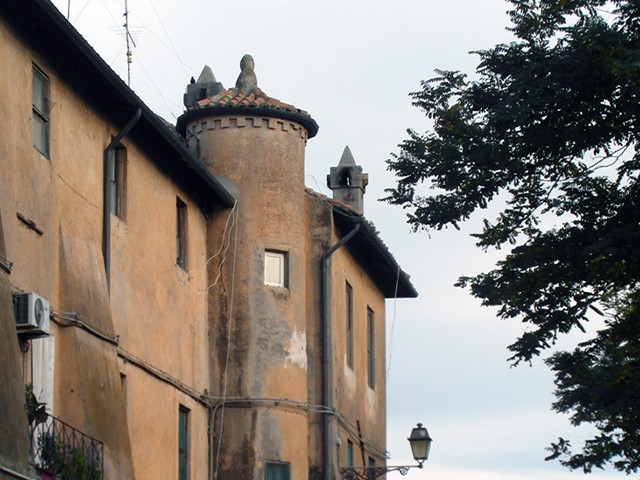Episcopio or Castello di Porto in Fiumicino
Everything about the Episcopio di Porto in Fiumicino: history, location, how to get there and other useful information to visit the castle and the church of the villageAlong via Portuense, not far from the access to the Oasis of Portus and the Archeological Area of the Harbour of Trajan, is the imposing medieval village of Episcopio di Porto, also known as Castello di Porto.
From the original complex have been preserved the crenellated city walls and the entrance gate with the coat of arms of Pope Sixtus IV, who in 1483, hosted by Bishop Rodrigo Borgia, commissioned some restoration works.
The village, bishop seat of Portus and Santa Rufina, on Medieval times, after the ancient city of Portus had been abbandoned, took on a defensive role in front of barbarian raids.

Episcopio di Porto - Fiumicino - Wikipedia CC BY-SA 4.0 - Pere Garcia
In the 11th century Pope Benedict III transformed it into a military garrison and the village was fortified during the next century and then again in the XVI century, thanks to the works of Cardinal Corneo, who in 1538 commissioned restoration works, as witnessed by an inscription in the inner courtyard.
The current aspect of the complex is owed to the last restoration work carried out by the Superintendence for the Environmental and Architectural Heritage of the Lazio on the occasion of the Jubilee of the year 2000. These affected the outer city walls, the facade of the Church and of the Bishop place, the inner courtyard, the entrance gate, the clock tower, which was then brought back into operation and the construction of a new lighting system that allows you to admire the village also in the evening.
Through the entrance gate, built in 1771 by Cardinal Marcello Lante della Rovere with two marble columns coming from the nearby Necropolis of Portus, you can access the courtyard, the oldest part of the village.
The eighteenth-century courtyard is the work of the architects Gregorini and Passalacqua (authors of the Basilica of the Holy Cross in Jerusalem in Rome) and it houses the Church dedicated to Saint Hyppolitus and Lucy, where there are the relics of the patron saint of Fiumicino.
The church, rebuilt in 1582, was extended toward the end of the 17th century by Cardinal Flavio Chigi, who also created a new chapel in honor of Saint Erasmus and realized the clok tower.
Ancient city of Portus: a little bit of history
Before going inside this evocative medieval village, you have to know that its construction is closely linked to the events of the ancient city of Portus.
Porto, in fact, was born around the ancient port docks of Claudius and Trajan and exploiting the proximity to the Tiber river, for many centuries played a strategic role in respect of Rome as the main commercial port.
The construction of the city walls dates back to the beginning of the 4th century, in the Constantinian era and despite the barbarian invasions and the destruction, it maintained its vital function regarding Rome until the 9th century.
Then began a phase of decline that would lead progressively to the abandonment of the inhabited center. In the 16th century architects of the caliber of Pirro Ligorio, Baldassarre Peruzzi and Andrea Palladio began to study the ruins and in the 19th century started a systematic excavation campaign thanks to which today we can admire the remains of this ancient settlement, visiting also the Archaeological Area of the Harbour of Trajan and the nearby Necropolis.
Useful information
Episcopio di Porto in Fiumicino
- HOW TO GET THERE
The complex of Episcopio di Porto is on via Portuense not far from the access to the Oasis of Portus.
- PRICES
Free admission



 PORT MOBILITY CIVITAVECCHIA
PORT MOBILITY CIVITAVECCHIA













